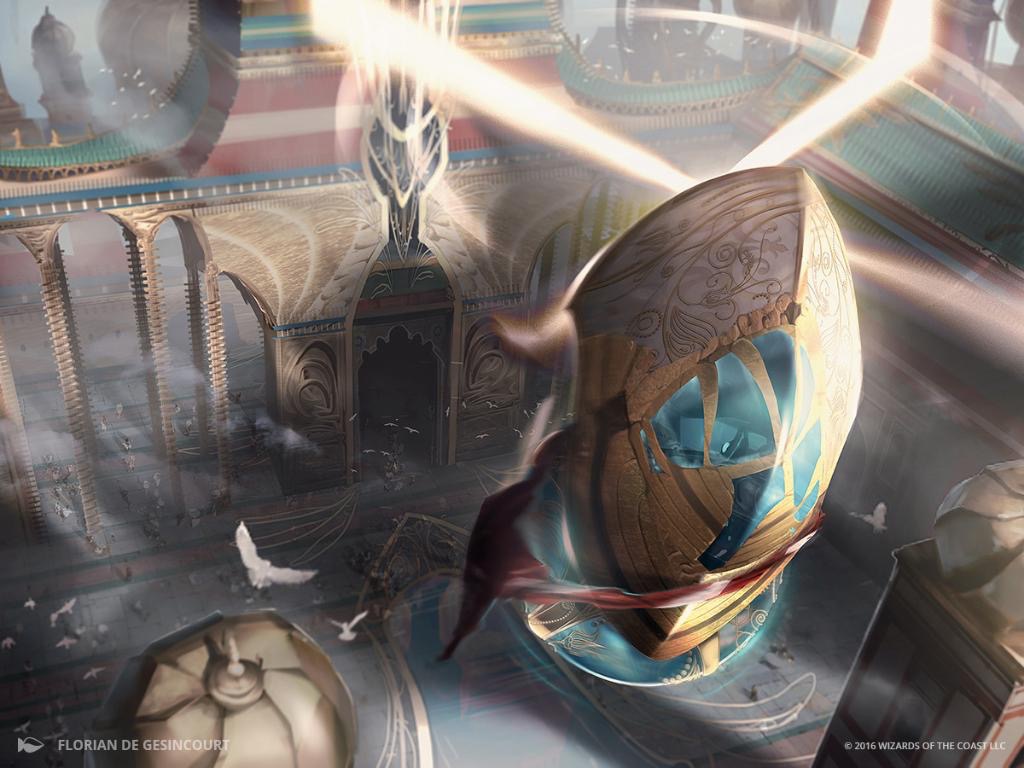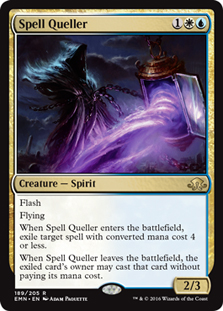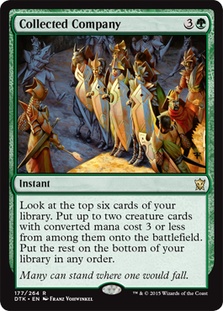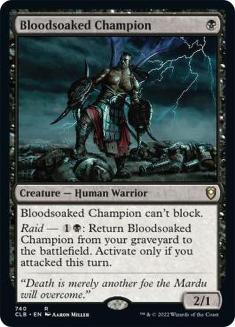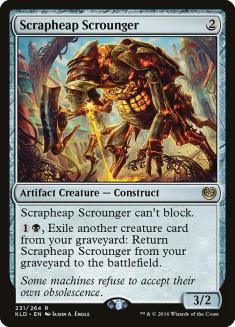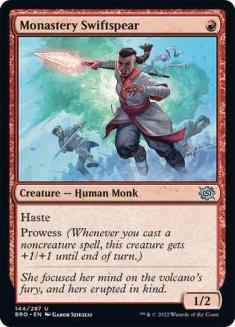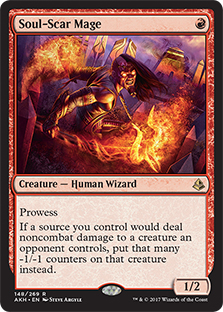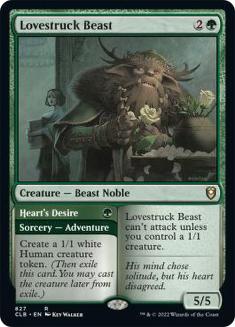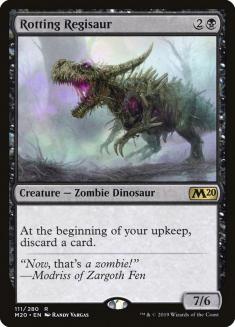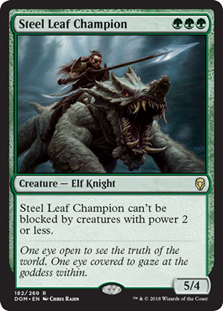Aggro decks have been a huge part of Pioneer since the format’s inception last October. Mono-Green Devotion dominated the format’s early days with a more aggressive take centered around Vivien, Arkbow Ranger and Walking Ballista rather than going big on card advantage with Hydroid Krasis. Later on, Mono-Black Aggro was largely responsible for Smuggler’s Copter being banned.
Creatures (22)
- 4 Llanowar Elves
- 4 Burning-Tree Emissary
- 4 Elvish Mystic
- 2 Courser of Kruphix
- 4 Walking Ballista
- 4 Voracious Hydra
Planeswalkers (6)
Lands (20)
Spells (12)

Creatures (24)
- 4 Bloodsoaked Champion
- 4 Scrapheap Scrounger
- 4 Night Market Lookout
- 4 Spawn of Mayhem
- 4 Knight of the Ebon Legion
- 4 Murderous Rider
Lands (24)
Spells (12)
Sideboard

The prevalence of aggressive strategies continued into the new year with Mono-Red Aggro, Mono-Black Aggro, and Bant Spirits performing well across the Players Tours. But as the metagame has condensed around Dimir Inverter and Sultai Delirium, things have gotten hard for those of us who love getting into the red zone early and often. The performance of Pioneer’s aggro decks has steadily dropped in recent weeks, culminating in last weekend’s Pioneer Open where the previous top aggressive strategies – Bant Spirits, Mono-Black Aggro, and Mono-Red Aggro – all failed to crack the Top 16.
It’s hard to crack a top tier that consists of decks as powerful and consistent as Dimir Inverter and Sultai Delirium, and while the aggro decks of Pioneer have performed well at various points in time, in the long run they all come up short in some way. Today I’m going to look closely at all of these archetypes in an attempt to diagnose the flaws that have forced them to Pioneer’s second tier.
Bant Spirits
Creatures (32)
- 4 Rattlechains
- 4 Spell Queller
- 3 Selfless Spirit
- 4 Mausoleum Wanderer
- 4 Nebelgast Herald
- 4 Supreme Phantom
- 1 Deputy of Detention
- 4 Empyrean Eagle
- 4 Spectral Sailor
Lands (24)
Spells (4)

I have some experience with this archetype, having played it in the recent Team Constructed Open in Philadelphia. I was attracted to the idea of an aggressive strategy that could disrupt the combo decks while simultaneously establishing a clock. Bant Spirits performed well enough against Dimir Inverter in that tournament, but as a known quantity, it has some problems.
First is the fact that it doesn’t have much malleability in deckbuilding. You need a pile of Spirits to take advantage of the tribal synergies and Collected Company, so maindecks only vary by a couple of cards. That isn’t a big problem when your deck isn’t a known quantity, but being able to juke when the metagame starts targeting you is a hallmark of successful decks, and Bant Spirits has real trouble doing that.
You get access to some good counterspells and hate cards in the sideboard but Mystical Dispute is a lot better against you than it is for you, so the proliferation of that card is a major issue. Bant Spirits trades on tempo and a Mana Leak for one mana can blunt any tempo advantage you gained in a hurry.
Second is a consequence of the deck’s manabase. Since it is three colors, you need to play a higher land count than the curve would otherwise dictate, leaving you prone to flooding. Spectral Sailor can mitigate this issue to some degree, but if you’re low on resources already because of mana flood, it’s all the tougher to protect the 1/1 flyer. Also, Bant Spirits needs to prioritize having a strong opening curve, so it wants to mulligan aggressively, further depleting your resources.
Zan Syed’s Azorius Spirits list gets to play a couple of utility lands by cutting a color, but the gains are small given how poor the mana is for aggressive decks in friendly color pairs. And sacrificing Collected Company is a big ask.
Creatures (30)
- 4 Rattlechains
- 4 Spell Queller
- 4 Selfless Spirit
- 4 Mausoleum Wanderer
- 4 Supreme Phantom
- 4 Empyrean Eagle
- 4 Spectral Sailor
- 2 Brazen Borrower
Planeswalkers (3)
Lands (24)
Spells (3)

Bant Spirits has draws that look unbeatable, but it’s not stable enough to be a consistent player over a large sample size of tournaments. If you look at Dimir Inverter and Sultai Delirium, they have a lot more flexibility in build and card selection to ensure they are nearly always doing something powerful.
Mono-Black Aggro
Creatures (25)
- 1 Herald of Torment
- 4 Bloodsoaked Champion
- 4 Scrapheap Scrounger
- 4 Dread Wanderer
- 4 Knight of the Ebon Legion
- 4 Rankle, Master of Pranks
- 4 Murderous Rider
Lands (24)
Spells (11)

In a combo-heavy metagame, a deck that combines early aggression with Thoughtseize and other disruption like Leyline of the Void or Infinite Obliteration seems like an easy winner, but Mono-Black Aggro has fallen off recently outside of a couple of the SCG Tour’s best players taking it to the Top 8 of a Classic, which is far from a ringing endorsement given that Daryl and Drake could put up the same finish with ham sandwiches.
The attractiveness of cheap creatures backed up by Thoughtseize notwithstanding, the issue with Mono-Black Aggro is that the combo decks at the top of the metagame took away its greatest strength: staying power. The combination of recursive threats and two great utility lands meant that Mono-Black Aggro never runs out of things to do with its mana, a rare trait for an aggro deck.
But now, if you try to play an attrition game against removal, Inverter of Truth, Underworld Breach, and even Heliod, Sun-Crowned can and will ruin your day. All of these decks just need to buy enough time to execute their combos, so they aren’t nearly as concerned about Bloodsoaked Champion and Scrapheap Scrounger coming back down the line.
Even Sultai Delirium has Emrakul, the Promised End and Uro, Titan of Nature’s Wrath to trump a pile of extra 2/1s in the late-game, so while they don’t have a combo finish to literally end the game, the advantage of Mono-Black Aggro’s threats is still effectively blunted.
Mono-Black Aggro doesn’t have a great depth of good creatures beyond the ones it already plays, so pivoting from this plan of being an aggro deck that grinds through opposing disruption is difficult. Recursive threats are what the color black offers to aggro decks, and when those threats aren’t as impressive, neither is black aggro.
Creatures (23)
- 3 Kalitas, Traitor of Ghet
- 4 Gifted Aetherborn
- 4 Dusk Legion Zealot
- 4 Champion of Dusk
- 4 Knight of the Ebon Legion
- 4 Murderous Rider
Planeswalkers (4)
Lands (24)
Spells (9)

Note that this same issue plagues Mono-Black Vampires, which has an even higher curve and the robust card draw from Champion of Dusk, so if anything the lack of inevitability against combo decks is even more of a problem there.
Mono-Red Aggro
Creatures (29)
- 4 Goblin Rabblemaster
- 4 Monastery Swiftspear
- 2 Zurgo Bellstriker
- 3 Kari Zev, Skyship Raider
- 4 Soul-Scar Mage
- 4 Bonecrusher Giant
- 4 Torbran, Thane of Red Fell
- 4 Rimrock Knight
Lands (23)
Spells (8)
Sideboard

Mono-Red Aggro is one of the biggest enigmas in Pioneer. It’s been four months and no one can agree on what the best list of the deck looks like, beyond the one-drop prowess creatures, Wild Slash, and Lightning Strike. With so many options, it would seem like there should be a Mono-Red Aggro list that can succeed in any metagame, but if anything, the opposite has been the case.
The fundamental issue with Mono-Red Aggro is that despite a deep pool of cards to draw from, it doesn’t have enough good one-drops. Monastery Swiftspear and Soul-Scar Mage are good cards, but the pool quickly drops off after that with cards like Bomat Courier and Zurgo Bellstriker.
Once you accept that your deck starts with two prowess creatures, the natural next step is to go for a burn-heavy route, but Pioneer doesn’t really have the tools for such a deck. There are enough burn spells to fill out a 60-card list, but it’s a low-power strategy given you’re missing so many of the best tools from Modern, namely Lava Spike, Lightning Bolt, and Searing Blaze.
More recently, we’ve seen Mono-Red Aggro pilots incorporate Adventure creatures like Rimrock Knight and Bonecrusher Giant in order to effectively increase their spell count without resorting to a pile of burn spells. However, Rimrock Knight is an underpowered card, especially in a format where Walking Ballista and Satyr Wayfinder are staples and Stomp is only good in a metagame where there are lots of cheap creatures around, which for Pioneer has stopped being the case.
Given these issues, it’s no surprise that the most successful red decks have been slower and more reliant on the bevy of powerful three- and four-mana spells available to red mages in Pioneer. When Glorybringer stopped being good, so did packing your deck with basic Mountains.
Golgari Aggro
Creatures (34)
- 4 Llanowar Elves
- 4 Scavenging Ooze
- 4 Elvish Mystic
- 3 Rishkar, Peema Renegade
- 2 Rhonas the Indomitable
- 3 Ghalta, Primal Hunger
- 4 Steel Leaf Champion
- 4 Rotting Regisaur
- 4 Lovestruck Beast
- 2 Yorvo, Lord of Garenbrig
Lands (20)
Spells (6)

The only true aggro deck to make the Top 8 of the Open last weekend, Golgari Aggro had a horrible performance at the Players Tours and was all but left for dead as a viable archetype in Pioneer. But there are some things to like here, most notably the prevalence of powerful three-drops.
It’s no easy task to turn revolt on in Pioneer, so decks relying on Fatal Push can struggle to answer three-mana creatures. This deck has plenty of those, and all of them are capable of ending the game quickly with little help, so if one of them sticks you have a healthy clock. And you get to back that clock up with great disruption from the sideboard in Thoughtseize and Leyline of the Void.
However, Golgari Aggro suffers greatly from its awkward curve. Green decks dominated Pioneer in the fall in large part due to Once Upon a Time raising their level of consistency, but without it, they fail to have a mana creature too often – not to mention the times when that mana creature dies and you have no follow-up.
That puts this deck in Bant Spirits territory for me, albeit with the trade-off of less disruption for a more reliable clock. Golgari Aggro is going to have draws that look unbeatable by players who are putzing around with Opts and Satyr Wayfinders in the early-game, but it will also lose plenty of games to its weak draws with no way to sculpt its draw beyond mulliganing.
Lastly, as Ari Lax detailed in his article earlier this week, Golgari Aggro struggles against some of the less popular decks in the metagame, like Azorius Control. The metagame has condensed somewhat, but you’re still not playing against Dimir Inverter and Sultai Delirium every round, and matching up well against the riff-raff in the room is important. Part of what makes those two decks so good is that they’re powerful enough to always have a good plan for unexpected matchups. Golgari Aggro does not.
Mono-White Devotion
Creatures (25)
- 3 Knight of the White Orchid
- 2 Anafenza, Kin-Tree Spirit
- 4 Thraben Inspector
- 4 Walking Ballista
- 3 Benalish Marshal
- 1 Tomik, Distinguished Advokist
- 2 Arcanist's Owl
- 2 Daxos, Blessed by the Sun
- 4 Heliod, Sun-Crowned
Planeswalkers (5)
Lands (26)
Spells (4)

Honestly, I have a hard time counting a deck with Arcanist’s Owl an aggro deck, but given its breakout performance last weekend and significant presence in the online metagame, Mono-White Devotion bears mention.
In particular, I want to mention Jameson Perdue’s inclusion of Benalish Marshal, trimming Owl to lower the curve and help those mopey Thraben Inspectors and Knight of the White Orchids beat down. His list certainly takes a more aggressive posture than what we’ve seen recently, and I think that greatly improves the deck.
This deck has good disruption for the various combos in the format, most notably Gideon of the Trials; a reasonable clock, though not as good as for the previously listed decks; and a combo of its own to play towards if your opponent overloads on removal for your aggro plan. The fact that Heliod, Sun-Crowned is resilient to most every removal spell in the format means you’ll likely have the threat of the combo in every game you draw it, so there’s more peace of mind here than most creature-combo decks have against heavy-removal strategies.
The previous aggro decks have suffered from either lack of relevant versatility, but Mono-White Devotion has a relevant versatility in its gameplan, and increasing the aggro plan only helps that versatility, since the aggro plan is currently less robust than the combo. A deck that is more adept at pressuring the opponent will take the heat away from the combo elements, forcing the opponent to answer threats that would become irrelevant in a longer game and divert resources away from disrupting the combo.
The primary weakness of Mono-White Devotion will always be its comparatively bad removal. But against Dimir Inverter and Sultai Delirium, there isn’t much opportunity to use spot removal spells, and one of the cards that Mono-White Devotion plays, Baffling End, actually matches up well against the most important threat across both of those matchups: Uro, Titan of Nature’s Wrath.
Mono-White Devotion is the most intriguing deck to come out of this weekend, and I think there’s a lot of potential by pushing the aggro plan to its potential without sacrificing too much from the combo plan.
I’ve been trying hard to find an aggro deck to champion in Pioneer, but it’s tough right now when the best decks have the best cheap removal, and cards that quickly turn the corner in Inverter of Truth and Uro. Perhaps a more aggressive list of Mono-White Devotion is the answer, but we may have to go back to the drawing board to figure out how to tackle the Tier 1 decks in Pioneer.

